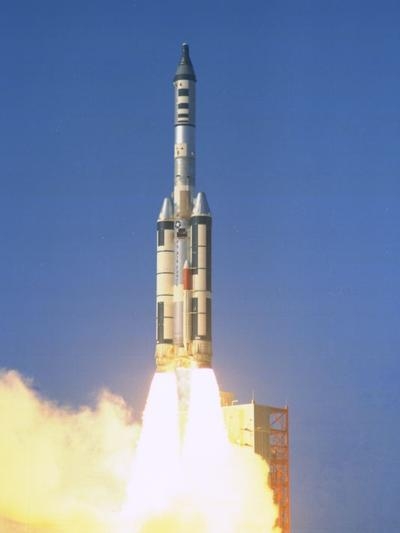Tue, Nov 08, 2016
But Manned Orbiting Laboratory Was A Short-Lived Idea
Last week, the U.S. Air Force celebrated the 50th anniversary of the only launch in the Manned Orbiting Laboratory (MOL) program. The November 3 flight would determine if a modified Gemini capsule could survive re-entry after a hatch had been cut into its heat shield.

The hatch would have allowed astronauts to move between the capsule and a planned laboratory situated below.
While the capsule survived the 33 minute suborbital flight, the program did not.
Florida today reports that the program was cancelled less than three years later in 1969.
But the capsule is a one-of-a-kind artifact. It is the only Mercury, Gemini, or Apollo capsule ever to fly into space twice. It was also the only capsule to fly in space carrying U.S. Air Force markings.
According to the National Reconnaissance Office, The Manned Orbiting Laboratory (MOL) was a 1960s Air Force program with the ostensible mission to place military personnel in orbit to conduct scientific experiments to determine the “military usefulness” of placing man into space and the techniques and procedures for doing so if the need ever arose. The actual, classified, mission of the MOL program was to place a manned surveillance satellite into orbit. At the time, several military and contractor studies estimated that manned surveillance satellites could acquire photographic coverage of the Soviet Union with resolution better than the best system at the time (the first generation Gambit satellite). Additionally, the Air Force billed the MOL as a reconnaissance system that could more efficiently and quickly adjust coverage for crises and targets of opportunity than unmanned systems. The Air Force controlled development of the satellite, which was consistent with MOL’s unclassified
mission, while the NRO ran development of the covert reconnaissance mission of the program, including the camera system and other subsystems.
The MOL-B test flight came less than 10 years after the Soviets launched Sputnik and sparked the space race. But satellite technology advanced quickly, and made a manned program unnecessary.
(NASA Image)
More News
Its Offerings Are Lighter, Cleaner, and Now Pushing Past 1,000nm on SAF Jet Fuel DeltaHawk’s diesel-powered aircraft lineup has seen incredible upgrades over the last few yea>[...]
The Airplane Experienced A Total Loss Of Engine Power On December 3, 2025, about 1600 central standard time, a Mooney Aircraft Corp. M20K, N57229, was substantially damaged when it>[...]
Make Sure You NEVER Miss A New Story From Aero-News Network Do you ever feel like you never see posts from a certain person or page on Facebook or Instagram? Here’s how you c>[...]
Aero Linx: European Society of Aerospace Medicine (ESAM) As a pan-European, independent forum, it works to promote the safety and health of all persons involved in aviation and spa>[...]
“We are excited to see Wisk achieve this milestone, and I’m so proud of the team that made it possible. The team at Wisk has built advanced technologies across flight c>[...]
 Aero-TV: DeltaHawks Diesel Power Steps Into the Spotlight
Aero-TV: DeltaHawks Diesel Power Steps Into the Spotlight NTSB Prelim: Mooney Aircraft Corp. M20K
NTSB Prelim: Mooney Aircraft Corp. M20K ANN FAQ: Turn On Post Notifications
ANN FAQ: Turn On Post Notifications ANN's Daily Aero-Linx (12.20.25)
ANN's Daily Aero-Linx (12.20.25) Aero-News: Quote of the Day (12.20.25)
Aero-News: Quote of the Day (12.20.25)



